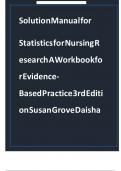Solution Manual for
’ ’
Statistics for Nursing R’ ’ ’
esearch A Workbookfo
’ ’ ’
r Evidence-
’
Based Practice 3rd Editi
’ ’ ’
on Susan Grove Daisha
’ ’ ’
, Answer Guidelines for Questions to Be Graded
’ ’ ’ ’ ’ ’
Identifying Levels of EXERCISE ’
1
’ ’ ’
Measurement: Nominal, Or ’ ’
dinal, Interval, and Ratio
’ ’ ’
The’questions’are’in’bold’followed’by’answers.
1. In’Table’1,’identify’the’level’of’measurement’for’the’current’therapy’variable.’Provide’a’ra
tionale’for’your’answer.
Answer:’The’current’therapy’variable’was’measured’at’the’nominal’level.’These’drug’categories’
were’probably’developed’to’be’exhaustive’for’this’study’and’included’the’categories’of’drugs’the’s
ubjects’were’receiving.’However,’the’categories’are’not’exclusive,’since’patients’are’usually’on’m
ore’than’one’category’of’these’drugs’to’manage’their’health’problems.’The’current’therapies’are’n
ot’measured’at’the’ordinal’level’because’they’cannot’be’rank’ordered,’since’no’drug’category’can’be
’considered’ more’or’less’beneficial ’than’another ’drug’category’(see’Figure’1-
1;’Grove’&’Gray,’2019).
2. What’ is’ the’ mode’ for’ the’ current’ therapy’ variable’ in’ this’ study?’ Provide’ a’ rationale’ for’y
our’answer.
Answer:’ The’ mode’ for’ current’ therapy’ was’ β’blocker.’ A’ total’ of’ 100’ (94%)’ of’ the’ cardiac’ patients
were’ receiving’ this’ category’ of’ drug,’ which’ was’ the’ most’ common’ prescribed’ drug’ for’ this’s
ample.
3. What’statistics’were’conducted’to’describe’the’BMI’of’the’cardiac’patients’in’this’sample?’
Discuss’whether’these’analysis’techniques’were’appropriate’or’inappropriate.
Answer:’ BMI’ was’ described’ with’ a’ mean’ and’ standard’ deviation’ (SD).’ BMI’ measurement’ resulted’i
n’ratio-level’data’with’continuous’values’and’an’absolute’zero’(Stone’&’Frazier,’2017).’Ratio-
’level’data’should’be’analyzed’with’parametric’statistics’such’as’the’mean’and’SD’(Grove’&’Gray,’2
, 017;’Knapp,’2017).
4. Researchers’used’the’following’item’to’measure’registered’nurses’’(RNs)’income’in’a’study:’
What’category’identifies’your’current’income’as’an’RN?
a.’ Less’than’$50,000
b.’ $50,000’to’59,999
c.’ $60,000’to’69,999
d.’ $70,000’to’80,000
e.’ $80,000’or’greater
What’ level’ of’ measurement’ is’ this’ income’ variable?’ Does’ the’ income’ variable’ follow’ the’r
ules’outlined’in’Figure’1-1?’Provide’a’rationale’for’your’answer.
Answer:’In’this’ example,’ the’ income’ variable’is’measured’ at’the’ordinal’level.’ The’ income’ catego-
’ries’are’exhaustive,’ranging’from’less’than’$50,000’to ’greater’than’$80,000.’The’two’open-ended
AG’1-1
, AG’1-2 Answer’ Guidelines’ for’ Questions’ to’ Be’ Graded
categories’ensure’that’all’salary’levels’are’covered.’The’categories’are’not’exclusive,’since’catego-
r’ ies’(d)’and’(e)’include’an’$80,000’salary,’so’study’participants’making’$80,000’might’mark’eith
er’ (d)’ or’ (e)’ or’ both’ categories,’ resulting’ in’ erroneous’ data.’ Category’ (e)’ could’ be’ changedt’ o’gr
eater’than’$80,000,’making’the’categories’exclusive.’The’categories’can’be’rank’ordered’from’th
e’lowest’salary’to’the’highest’salary,’which’is’consistent’with’ordinal’data’(Grove’&’Gray,’2019;’
Waltz’et’al.,’2017).
5. What’level’of’measurement’is’the’CDS’score?’Provide’a’rationale’for’your’answer.
Answer:’The’CDS’score’is’at’the’interval’level’of’measurement.’The’CDS’is’a’26-
item’Likert’scale’developed’to’measure’depression’in’cardiac’patients.’Study’participants’rated’th
eir’symp-
’toms’on’a’scale’of’1’to’7,’with’higher ’numbers’indicating’increased’severity’in’the’depression’sy
mptoms.’The’total’scores’for’each’subject’obtained’from’this’multi-
item’scale’are’considered’to’be’at’the’interval’level’of’measurement’(Gray’et’al.,’2017;’Waltz’et’al.
,’2017).
6. Were’nonparametric’or’parametric’analysis’techniques’used’to’analyze’the’CDS’scores’for’t
he’cardiac’patients’in’this’study?’Provide’a’rationale’for’your’answer.
Answer:’Parametric’statistics,’such’as’ mean’ and’ SD,’ were’ conducted’ to’ describe’ CDS’ scores’for’
study’participants’(see’Table’1).’CDS’scores’are’interval-
level’data’as’indicated’in’Questions’5,’so’parametric’statistics’are’appropriate’for’this’level’of’data’(Gr
ay’et’al.,’2017;’Kim’&’Mallory,’2017).
7. Is’the’prevalence’of’depression’linked’to’the’NYHA’class?’Discuss’the’clinical’importance’o
f’this’result.
Answer:’The’study’narrative’indicated’that’the’prevalence’of’depression’increased’with’the’great
er’NYHA’class.’In’NYHA’class’III,’64%’of’the’subjects’were’depressed,’whereas’11%’of’the’subjec
ts’were’depressed’in’NYHA’class’I.’Thus,’as’the’NYHA’class’increased,’the’number’of’sub-
’jects’with’depression’increased.’This’is’an’expected’finding’because’as’the’NYHA’class’increases,’ca
rdiac’patients’have’more’severe’physical’symptoms,’which’usually’result’in’emotional’distress,’suc
h’ as’ depression.’ Nurses’ need’ to’ actively’ assess’ cardiac’ patients’ for’ depression,’ especially’ thosei’ n’hi
gher’NYHA’classes,’so’they’might’be’diagnosed’and’treated’as’needed.
8. What’frequency’and’percent’of’cardiac’patients’in’this’study’were’not’being’treated’with’a
n’antidepressant?’Show’your’calculations’and’round’your’answer’to’the’nearest’whole’per
cent’(%).




